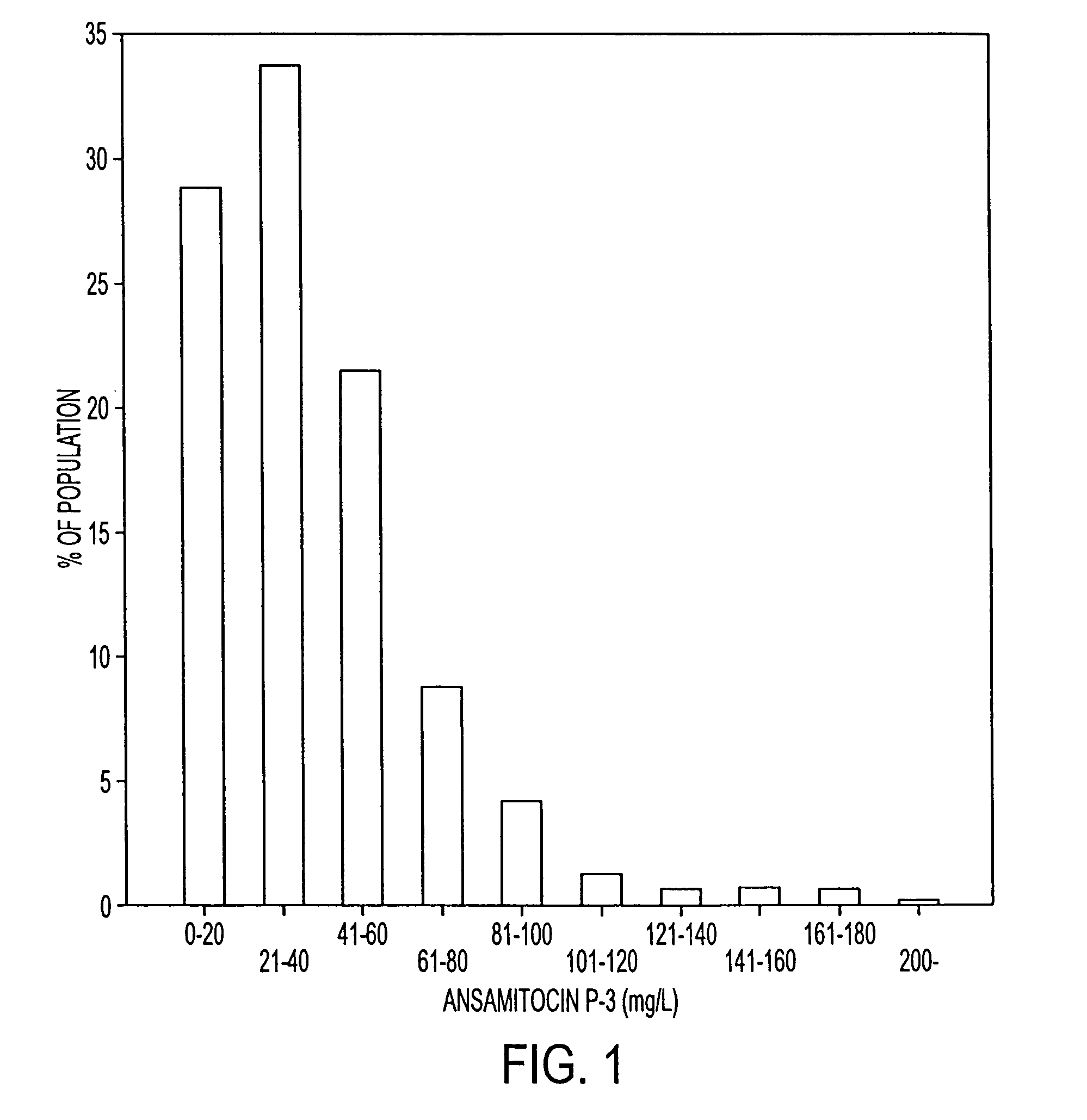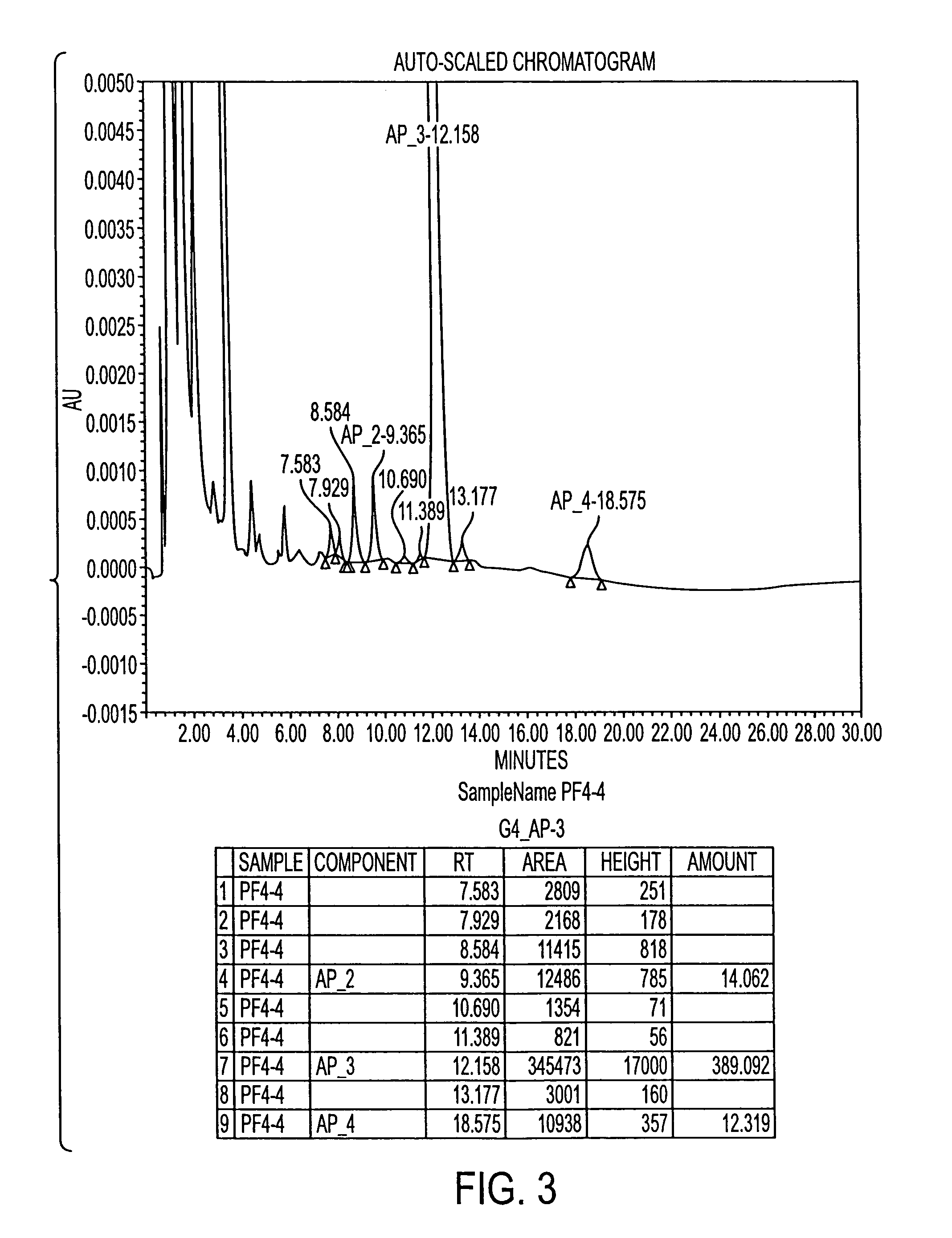Mutant Actinosynnema pretiosum strain with increased maytansinoid production
a technology of maytansinoid and mutant actinosynnema, which is applied in the field of microorganisms, can solve the problems of difficult production of maytansinoid from such sources, and achieve the effect of increasing the amount of maytansinoid and enhancing the production of maytansinoid
- Summary
- Abstract
- Description
- Claims
- Application Information
AI Technical Summary
Benefits of technology
Problems solved by technology
Method used
Image
Examples
example 1
[0077]UV Mutagenesis
[0078]Spores from an 8-day old slant preparation of colony No. 15-55 were collected by washing the slant [slant size: 2.3×18 cm tube filled with 16–18 mL of CM4-1 agar (for composition see Table 4)] with 10 mL of water. Five mL of the water with the suspended spores were placed in a screw cap tube (size: 1.1×11 cm) containing 10 glass beads of 2.0 mm diameter for maceration. The tube was vortexed for five minutes and the macerated spore suspension was then serially diluted into a 0.1% aqueous Tween 60 solution at 103, 104, and 105-fold dilutions. (The macerated suspension typically contains 2×109 cfu.) From each dilution, 0.1 mL of the suspension was plated on a CM4-1 agar plate (9.5 cm diameter), which was exposed to a suitable germicidal UV light source: the open agar plate was placed under a 15 W germicidal lamp at about 20 cm distance and exposed for 20–40 seconds to the UV light. (The killing rate for a 40 second exposure was about 99.9%.) The exposed plates...
example 2
[0079]MNNG Mutagenesis
[0080]Spores from an 8-day old slant preparation were collected by washing the slant (slant size: 2.3×18 cm tube filled with 16–18 mL of CM4-1 agar) with 10 mL of water. Five mL of the water with the suspended spores were placed in a screw cap tube (size: 1.1×11 cm) containing 10 glass beads of 2.0 mm diameter for maceration. The tube was vortexed for five minutes and the spores were collected by centrifugation at 2100×g for 15 min. The supernatant was discarded and the pellet was resuspended in 4 mL of sterile 0.05 M tris maleic acid buffer, pH 8.0 containing (w / v) 0.1% ammonium sulfate, 0.01% magnesium sulfate hepta-hydrate, 0.005% calcium chloride dihydrate, 0.00025% ferrous sulfate hepta-hydrate, and 100 μg / mL of MNNG. The suspension was vortexed for 30 min, then the reaction was stopped by the addition of 3 mL of a saturated sodium thiosulfate solution. The spores were collected by centrifugation, then resuspended in 5 mL of water. This suspension was used...
example 3
[0081]Shake Flask Fermentation to Produce Ansamitocin from PF4-4
[0082]A stored PF4-4 culture, for example a lyophilized or frozen culture, was grown on CM4-1 agar plates at 28° C. for 5–7 days. Single colonies were then transferred to a second, gridded CM4-1 agar plate, (typically 16 colonies were transferred to a plate of 9.5 cm diameter), and the plate was incubated at 28° C. for 7 days, during which period colonies of 6–15 mm in diameter grew. A single colony was then macerated by vortexing for 10 minutes in a closed tube containing ten 2-mm-diameter glass beads and 2 mL of water. Part of the colony suspension (0.5 mL) was then transferred to a 250 mL culture flask containing 30 mL seed medium, VM4-1′ (for composition, see Table 4). The seed flask was incubated on a rotary shaker (220 rpm, 70 mm throw) at 28° C. for 48 hours, after which 1 mL of the seed growth suspension was transferred to a 250 mL culture flask containing 20 mL of fermentation medium FM4-4. The fermentation fla...
PUM
| Property | Measurement | Unit |
|---|---|---|
| lengths of time | aaaaa | aaaaa |
| size | aaaaa | aaaaa |
| diameter | aaaaa | aaaaa |
Abstract
Description
Claims
Application Information
 Login to View More
Login to View More - R&D
- Intellectual Property
- Life Sciences
- Materials
- Tech Scout
- Unparalleled Data Quality
- Higher Quality Content
- 60% Fewer Hallucinations
Browse by: Latest US Patents, China's latest patents, Technical Efficacy Thesaurus, Application Domain, Technology Topic, Popular Technical Reports.
© 2025 PatSnap. All rights reserved.Legal|Privacy policy|Modern Slavery Act Transparency Statement|Sitemap|About US| Contact US: help@patsnap.com



